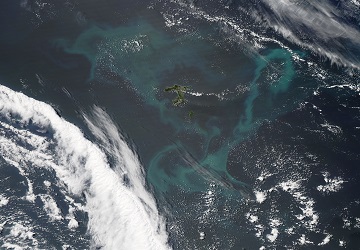论文标题:Leads in Arctic pack ice enable early phytoplankton blooms below snow-covered sea ice
期刊:Scientific Reports
作者:Philipp Assmy, Mar Fernández-Méndez, et al.
发表时间:2017/02/19
数字识别码:10.1038/srep40850
原文链接:https://www.nature.com/articles/srep40850?utm_source=Other_website&utm_medium=Website_links&utm_content=RenLi-Nature-Scientific_Reports-Ecology-China&utm_campaign=SCIREP_USG_JRCN_RL_seaice_sciencenet_article_3rd_July

《科学报告》发表的一项研究Leads in Arctic pack ice enable early phytoplankton blooms below snow-covered sea ice首次展示了在高纬度地区的浮冰层下,浮游植物提前大量繁殖的现象。
北极冰区正在迅速地从较厚的多年冰覆盖转变为一种更薄的季节性的一年冰覆盖,这一转变对北极的初级生产产生了重大影响。了解未来几十年里初级生产力将如何变化是一项重大的挑战。最近的研究报道了夏季海冰下浮游植物大量繁殖的现象,表明基于卫星估算得到的北极年度初级生产远远小于真实情况。来自挪威极地研究所的Philipp Assmy及其同事观测到了在北极浮冰下浮游植物春季大量繁殖的一个独特的时间序列。研究人员发现以棕囊藻(Phaeocystis pouchetii )为主的浮游植物的大量繁殖导致地表硝酸盐几近枯竭,并造成溶解无机碳平均下降16 ± 6 g m−2。该地区的海洋环流特征表明,尽管存在由雪覆盖的海冰,但是浮游植物还是在原地大量繁殖。出现该现象的原因主要是动态的冰层覆盖形成的通路为浮游植物的繁殖提供了充足的阳光。未来,尽管北极地区的降雪预计会增加,但随着海冰的变薄及动态运动,将会形成更多海洋通路,使冰层下浮游植物的大量繁殖变得更为普遍。这一现象可能会改变北冰洋的海洋生产力、海洋食物网以及碳封存。
摘要:The Arctic icescape is rapidly transforming from a thicker multiyear ice cover to a thinner and largely seasonal first-year ice cover with significant consequences for Arctic primary production. One critical challenge is to understand how productivity will change within the next decades. Recent studies have reported extensive phytoplankton blooms beneath ponded sea ice during summer, indicating that satellite-based Arctic annual primary production estimates may be significantly underestimated. Here we present a unique time-series of a phytoplankton spring bloom observed beneath snow-covered Arctic pack ice. The bloom, dominated by the haptophyte algae Phaeocystis pouchetii, caused near depletion of the surface nitrate inventory and a decline in dissolved inorganic carbon by 16 ± 6 g C m−2. Ocean circulation characteristics in the area indicated that the bloom developed in situ despite the snow-covered sea ice. Leads in the dynamic ice cover provided added sunlight necessary to initiate and sustain the bloom. Phytoplankton blooms beneath snow-covered ice might become more common and widespread in the future Arctic Ocean with frequent lead formation due to thinner and more dynamic sea ice despite projected increases in high-Arctic snowfall. This could alter productivity, marine food webs and carbon sequestration in the Arctic Ocean.
阅读论文全文请访问:https://www.nature.com/articles/srep40850?utm_source=Other_website&utm_medium=Website_links&utm_content=RenLi-Nature-Scientific_Reports-Ecology-China&utm_campaign=SCIREP_USG_JRCN_RL_seaice_sciencenet_article_3rd_July
期刊介绍:Scientific Reportsis an online, open access journal from the publishers of Nature. We publish scientifically valid primary research from all areas of the natural and clinical sciences.
The 2016 journal metrics for Scientific Reports are as follows:
•2-year impact factor: 4.259
•5-year impact factor: 4.847
•Immediacy index: 0.647
(来源:科学网)
特别声明:本文转载仅仅是出于传播信息的需要,并不意味着代表本网站观点或证实其内容的真实性;如其他媒体、网站或个人从本网站转载使用,须保留本网站注明的“来源”,并自负版权等法律责任;作者如果不希望被转载或者联系转载稿费等事宜,请与我们接洽。